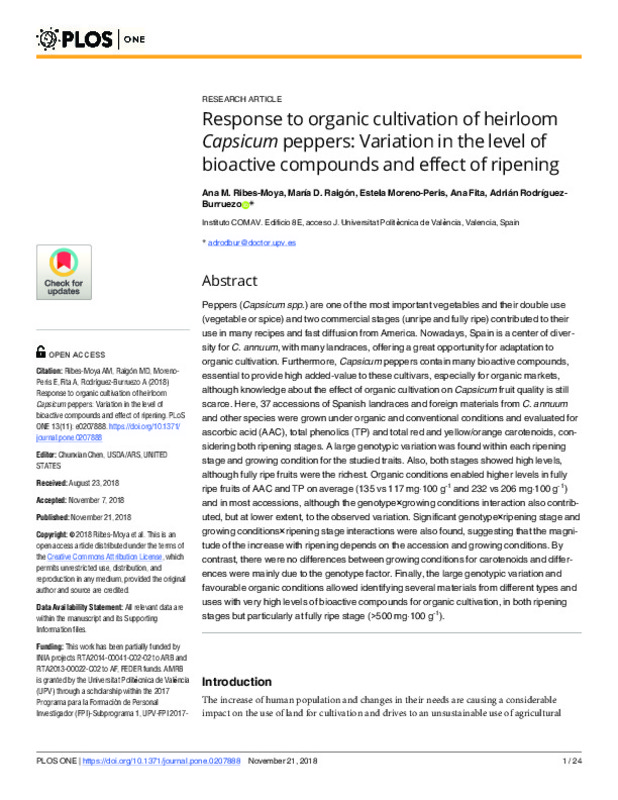JavaScript is disabled for your browser. Some features of this site may not work without it.
Buscar en RiuNet
Listar
Mi cuenta
Estadísticas
Ayuda RiuNet
Admin. UPV
Response to organic cultivation of heirloom Capsicum peppers: Variation in the level of bioactive compounds and effect of ripening
Mostrar el registro sencillo del ítem
Ficheros en el ítem
| dc.contributor.author | Ribes Moya, Ana María
|
es_ES |
| dc.contributor.author | Raigón Jiménez, Mª Dolores
|
es_ES |
| dc.contributor.author | Moreno Peris, Estela
|
es_ES |
| dc.contributor.author | Fita, Ana
|
es_ES |
| dc.contributor.author | Rodríguez Burruezo, Adrián
|
es_ES |
| dc.date.accessioned | 2019-09-26T09:59:06Z | |
| dc.date.available | 2019-09-26T09:59:06Z | |
| dc.date.issued | 2018 | es_ES |
| dc.identifier.issn | 1932-6203 | es_ES |
| dc.identifier.uri | http://hdl.handle.net/10251/126417 | |
| dc.description.abstract | [EN] Peppers (Capsicum spp.) are one of the most important vegetables and their double use (vegetable or spice) and two commercial stages (unripe and fully ripe) contributed to their use in many recipes and fast diffusion from America. Nowadays, Spain is a center of diversity for C. annuum, with many landraces, offering a great opportunity for adaptation to organic cultivation. Furthermore, Capsicum peppers contain many bioactive compounds, essential to provide high added-value to these cultivars, especially for organic markets, although knowledge about the effect of organic cultivation on Capsicum fruit quality is still scarce. Here, 37 accessions of Spanish landraces and foreign materials from C. annuum and other species were grown under organic and conventional conditions and evaluated for ascorbic acid (AAC), total phenolics (TP) and total red and yellow/orange carotenoids, considering both ripening stages. A large genotypic variation was found within each ripening stage and growing condition for the studied traits. Also, both stages showed high levels, although fully ripe fruits were the richest. Organic conditions enabled higher levels in fully ripe fruits of AAC and TP on average (135 vs 117 mg.100 g(-1) and 232 vs 206 mg.100 g(-1)) and in most accessions, although the genotype x growing conditions interaction also contributed, but at lower extent, to the observed variation. Significant genotype x ripening stage and growing conditionsxripening stage interactions were also found, suggesting that the magnitude of the increase with ripening depends on the accession and growing conditions. By contrast, there were no differences between growing conditions for carotenoids and differences were mainly due to the genotype factor. Finally, the large genotypic variation and favourable organic conditions allowed identifying several materials from different types and uses with very high levels of bioactive compounds for organic cultivation, in both ripening stages but particularly at fully ripe stage (>500 mg.100 g(-1)). | es_ES |
| dc.description.sponsorship | This work has been partially funded by INIA projects RTA2014-00041-C02-02 to ARB and RTA2013-00022-C02 to AF, FEDER funds. AMRB is granted by the Universitat Politecnica de Valencia (UPV) through a scholarship within the 2017 Programa para la Formacion de Personal Investigador (FPI)-Subprograma 1, UPV-FPI 2017-Subprograma 1 -no 34. The funders had no role in study design, data collection and analysis, decision to publish, or preparation of the manuscript. | |
| dc.language | Inglés | es_ES |
| dc.publisher | Public Library of Science | es_ES |
| dc.relation.ispartof | PLoS ONE | es_ES |
| dc.rights | Reconocimiento (by) | es_ES |
| dc.subject.classification | EDAFOLOGIA Y QUIMICA AGRICOLA | es_ES |
| dc.subject.classification | GENETICA | es_ES |
| dc.title | Response to organic cultivation of heirloom Capsicum peppers: Variation in the level of bioactive compounds and effect of ripening | es_ES |
| dc.type | Artículo | es_ES |
| dc.identifier.doi | 10.1371/journal.pone.0207888 | es_ES |
| dc.relation.projectID | info:eu-repo/grantAgreement/MINECO//RTA2014-00041-C02-02/ES/Selección y mejora de variedades tradicionales de pimiento (Capsicum annuum L.) para rendimiento y calidad de fruto y adaptadas a cultivo ecológico/ | es_ES |
| dc.relation.projectID | info:eu-repo/grantAgreement/MINECO//RTA2013-00022-C02-02/ES/Obtención de patrones de pimiento tolerantes a bajos insumos de fósforo y genética de la adaptación radicular a estreses abióticos/ | es_ES |
| dc.rights.accessRights | Abierto | es_ES |
| dc.contributor.affiliation | Universitat Politècnica de València. Departamento de Biotecnología - Departament de Biotecnologia | es_ES |
| dc.contributor.affiliation | Universitat Politècnica de València. Departamento de Química - Departament de Química | es_ES |
| dc.contributor.affiliation | Universitat Politècnica de València. Instituto Universitario de Conservación y Mejora de la Agrodiversidad Valenciana - Institut Universitari de Conservació i Millora de l'Agrodiversitat Valenciana | es_ES |
| dc.description.bibliographicCitation | Ribes Moya, AM.; Raigón Jiménez, MD.; Moreno Peris, E.; Fita, A.; Rodríguez Burruezo, A. (2018). Response to organic cultivation of heirloom Capsicum peppers: Variation in the level of bioactive compounds and effect of ripening. PLoS ONE. 13(11). https://doi.org/10.1371/journal.pone.0207888 | es_ES |
| dc.description.accrualMethod | S | es_ES |
| dc.relation.publisherversion | http://doi.org/10.1371/journal.pone.0207888 | es_ES |
| dc.description.upvformatpinicio | e0207888 | es_ES |
| dc.type.version | info:eu-repo/semantics/publishedVersion | es_ES |
| dc.description.volume | 13 | es_ES |
| dc.description.issue | 11 | es_ES |
| dc.identifier.pmid | 30462729 | |
| dc.identifier.pmcid | PMC6249006 | |
| dc.relation.pasarela | S\378550 | es_ES |
| dc.contributor.funder | Instituto Nacional de Investigación y Tecnología Agraria y Alimentaria | es_ES |








